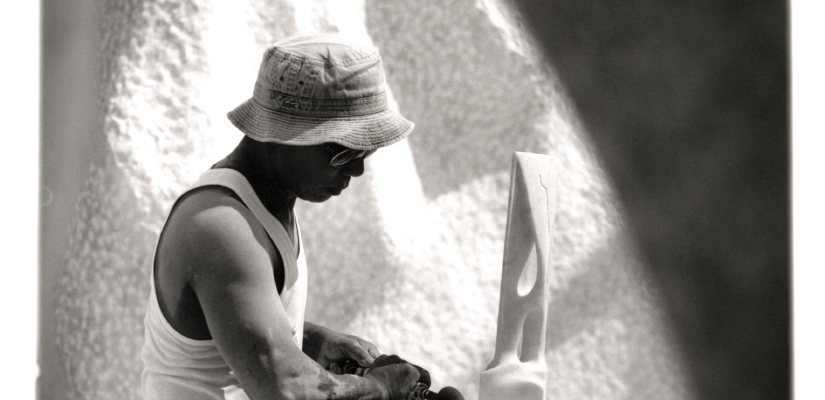
There can be no doubt that Kuetani’s vocation is to operate as a sculptor in a primarily environmental dimension. Although his qualities of sculptural imagination also prove highly impressive in object-sized work, the power and density of his sculptural invention can certainly be appreciated to the full in his environmental works, which are those that constitute the bulk of his sculptural output so far. Since the sculpture created in Villa Desideri at Marino near Rome in 1981, Kuetani has been aware that the greatest goal his sculptural work could be offered lies in the realm of environmental space, something that involves a whole range of relations that are unknown in object-sized sculpture. While the latter manifests its qualities regardless of specific spatial circumstances, sculptural work that measures itself against the environment inevitably involves the creation of a particular relationship with the environmental situation in which the work is situated, with the conditions of its accessibility, and with the signs characterizing it. If correctly understood, the demands of working in the environmental dimension thus involve far greater complexity for the sculptor than working in the object-oriented dimension.
In their careers many sculptors have had the opportunity to create “monuments”, although object-sized sculpture remains the most appropriate yardstick of their activities. When producing monuments, such sculptors have generally effected an enlargement of an object-sized work. Being an environmental sculptor does not, however, simply mean working in external space, i.e. placing large or not so large sculptures in squares, parks or gardens with no attention to the relationship between the plastic object and the environmental situation it is placed in. On the contrary, it means being aware of the need to plan one’s work specifically, case by case, in relation to the environmental situation in which one intends to operate. It therefore means bearing in mind a multiplicity of factors such as the morphological characterization of the space involved, its social function, its characteristic features and the legacy of memories attached to it, as well as its rationale and any specific urban function it may have.
While every sculpture naturally involves an implicit idea of spatiality, in the case of object-sized sculpture this spatiality is self-sufficient and hence substantially indifferent to the setting in which the sculpture itself may be placed. In short, the sculptural object can be placed anywhere as long as its interpretability is guaranteed. Environmental sculpture is instead wholly conditioned by the spatiality of the environment for which it is designed, and its creator must therefore be capable of imaginative planning that is capable of entering into a dialectical relationship with that spatiality, of interpreting it or modifying it, in short of taking complete control of it. Ultimately this involves a spatially more complex unit where the sculpture as structure finally becomes an element that conditions the environmental spatiality within which it operates in a new way.
The traditional “monument” constitutes a large sculpture placed in an external space, in a square, street or park, but its relationship with this space proves to be merely tangential. In short, the self-sufficient spatiality of monumental sculpture does not impinge upon the spatial consistency of the place that accommodates it. It can at most constitute a point of reference, but not an element capable of substantially modifying the consistency of the place that accommodates it. The spatiality of monumental sculpture and that of the place accommodating it come together and touch, but with no substantial reciprocal interference. It is indeed true that monuments can be moved from one part of the city to another for reasons of traffic or other considerations.
Environmental sculpture is inseparable linked from the very outset to the morphology of the place where it is created, and hence fuses with its spatial consistency to form a single whole. Environmental sculpture thus determines the spatial morphology of the place in which it is created precisely because the imaginative plan shaping it has entered into a dialectical and therefore modificatory relationship with the spatiality of the place. Environmental sculpture therefore operates in a spatially open fashion and reconstitutes its own autonomy only through a conclusive dialectical appropriation of the spatial morphology of the place in which it is created.
For Kuetani environmental sculpture means not only the dialectical insertion of his plastic work into an environmental context, but also the arrangement of the plastic event within this space in such a way as to construct both an external environmental spatial relationship and an internal environmental spatial condition. In short, the work is presented as an environmental event in relation to the given space, but also as a further environmental condition constituted within the event itself. Kuetani’s environmental sculptures are therefore nearly always accessible and negotiable, suggesting not only a visual environmental display of formal structures but also their tangible physical usability; suggesting that they can, in short, be used both as form and as matter in a dialectic interplay of constant alternation between the materiality of form and the materiality of stone.
